Abstract
This study investigates how virtual and augmented reality role games impact self-learning in higher education settings. A qualitative research–action approach that involved creating augmented reality micro-stories to encourage creativity and critical thinking was used. Through role-playing, students collaborated and gained a deeper understanding of the course, improving their self-learning abilities. The findings indicate that incorporating virtual and augmented reality into higher education positively affects self-learning, promoting active student engagement and meaningful learning experiences. Additionally, students perceive these immersive educational methods as bridging the gap between virtual and in-person learning environments, ultimately leading to enhanced educational results.
1. Introduction
Learning, by nature, is a collaborative process in which students work together and share resources to learn [1]. The teacher guides students in experimentation and exploration; individual learning is derived from group activities. The teacher must design learning problems to be solved in simulated learning environments and promote social participation and sustainable development. They should also consider interaction with the community and social projects and encourage creative and scientific thinking. Using technology and digital platforms in learning should create confidence in students and develop their digital skills. According to [2], virtuality in education responds satisfactorily to the needs of current social, cultural, and economic changes in Latin American digital times. These cultural aspects of student generations interacting with virtuality with their digital devices help create and build an equitable and inclusive society by developing active methodologies that allow learning and trusting of others in an interrelated and complex system. Digital models, which use modern techniques such as virtual reality (VR) and augmented reality (AR), should promote problem-solving that contributes to social well-being and the development of student expertise. Students should be able to interact with natural or very similar environments and apply their knowledge and skills to relevant situations [3].
To generate curiosity and prepare professionals for the future, the emerging education of a resilient, collaborative type that empowers everyone is role-playing, as noted by [4]. It promotes gamification, volunteering, self-motivation, myth, and fantasy; integrates knowledge in a globalizing way; considers creativity and construction of meanings, self-organization of knowledge, and critical thinking; grants the importance of small information, interaction among peers, dialogue, collaboration, teamwork, empathy, tolerance, decision-making and responsibility, personal self-affirmation, motivation to learn, security, and self-esteem; it responds to affective needs; fosters freedom of movement and expression; is therapeutic and liberating of tension, with anticipatory experiences; and is multicultural.
Self-Learning
As part of the learning process, we come across self-learning, which consists of students being able to independently identify, explore, develop, elaborate, observe, apply, analyze, and conclude educational activities. By working in teams in real-time virtual environments, students can interact with technology and their peers in a way that allows them to develop cognitive skills and a connective and virtual vision for learning in collaboration. Students can also be producers, creators, and consumers of their content when learning with role-playing games using AR and VR technologies. By facing situations of analysis and problem-solving in real-world or simulated environments, students can develop skills such as creativity, leadership, and self-management. Students can also develop a critical attitude by evaluating and analyzing information and applying their knowledge and skills to relevant situations [2].
Furthermore, self-learning can foster the development of identity and social responsibility by involving students in projects that benefit the community. In higher education, self-learning can have several problems and benefits [5,6,7].
Some potential problems of self-learning are
- Lack of motivation: Students may need help motivating themselves to learn independently, especially if they need a clear learning structure or incentives to learn.
- Lack of supervision: Students learning independently may need access to a teacher or tutor who can provide feedback or guidance during the learning process.
- Lack of social interaction: Collaborative learning may only be effective if students can interact with their classmates and discuss and debate ideas.
However, there are also several potential benefits of self-learning in higher education:
- Autonomy and responsibility: Self-learning can foster autonomy and responsibility in students by allowing them to take control of their learning process.
- Flexibility: Self-learning can be more flexible than traditional learning, as students can work at their own pace and in the place of their choice.
- Development of lifelong learning skills: Self-learning can help students develop lifelong learning skills, which can be helpful in their professional and personal lives.
- Increased participation and engagement: Students who participate in self-learning may show increased participation and engagement in their learning process and with learning materials.
The goal of this research is to explore the impact of VR and AR role-playing games on self-learning in higher education. The research question guiding our inquiry is: How do virtual and augmented reality role-playing games influence the self-learning processes of students in higher education? We aim to explore how VR and AR role-playing games can enhance self-directed learning in higher education.
2. Virtual Reality and Augmented Reality in Education
VR and AR have significantly evolved over the years, becoming pivotal technologies in higher education that offer immersive learning experiences and enhance the understanding of abstract concepts [8,9]. The main difference between VR and AR is their level of immersion and interaction. VR completely replaces the real world with a digital environment, providing a fully immersive experience. On the other hand, AR superimposes digital content onto the real world using devices like smartphones or AR glasses, allowing users to interact with both the real and digital worlds simultaneously.
The fundamental theories underpinning the use of VR and AR in education include constructivism, situated learning, and experiential learning, emphasizing the importance of interactive and hands-on learning experiences. These pedagogical theories align with the affordances of VR and AR, providing rich, interactive, and immersive learning environments that foster more profound understanding and engagement among students.
Azuma and Milgram’s seminal works fundamentally understand AR and VR. In particular, Azuma’s survey on AR laid the groundwork for comprehending how digital information could be overlaid in the real world, resulting in enhanced interactive experiences [10]. Milgram et al.’s classification of displays on the reality–virtuality continuum provides a framework for understanding the different immersive experiences offered by AR and VR [11].
A comprehensive overview of AR and Gamification in Education was provided in a recent systematic review conducted by Lampropoulos et al. [12]. The review showcased a range of applications and empirical studies exploring these technologies’ pedagogical benefits. This paper provides valuable insights into how AR and VR can be gamified to enhance learning engagement and outcomes.
Krug et al. [13] proposed a set of evaluation criteria that provide a structured approach for designing and analyzing AR applications in educational contexts. These criteria have been used in recent studies to compare and evaluate the effectiveness of AR applications in education. By doing so, they enabled a better understanding of AR and VR’s pedagogical benefits and challenges.
In higher education, VR and AR have been used in a variety of ways:
- Simulation of environments: VR and AR can simulate real-world or hypothetical environments, such as laboratories, hospitals, or extraterrestrial planets. Students can interact with these environments, practice skills, and make decisions in controlled contexts.
- Role-playing games: VR and AR can allow students to put themselves in the place of characters or professionals in different contexts and make decisions that affect the game’s outcome.
- Virtual tours: VR and AR can provide students with virtual tours of places that would otherwise be inaccessible or costly to visit in person, such as museums or historical sites.
- Presentations: VR and AR can be used to make presentations more interactive and engaging for students, for example, by adding augmented visual elements to a PowerPoint slide.
In addition, both AR and VR have been used in education to improve self-directed learning. The literature presents several works on this topic.
The study reported in [14] evaluated the use of AR in self-directed learning in special education. The results indicated that students were more excited and enthusiastic about classes during the experiment.
VR and AR can be effective for learning abstract or difficult-to-understand concepts. For example, a study found that students who used VR to learn about the lifecycle of a pipe wrench had a greater understanding of the concept and a higher retention of the information in the long-term [9].
AR has also been helpful in secondary education. For example, in [8], a study was reported in which history was taught to students, and the results showed that the students perceived high usability for this kind of application.
In higher education, AR role-playing games allow students to have the opportunity to assume the roles of characters or professionals in diverse scenarios and take actions that impact the game’s final result. Some examples of AR role-playing games used in higher education are:
- Escape rooms: Students must solve problems and decode clues to successfully “escape” the room before the time limit expires [15].
- AMELIO: To complete a mission in a space colony emergency, students must make team decisions using mixed reality games [16].
- Chariot Augmented Reality Medical (CHARM) simulator: In an AR environment, students must use their clinical skills and adhere to proper medical protocols to succeed in a cardiovascular life support (ACLS) simulation scenario [17].
Regarding the students’ perceptions, opinions, and attitudes, the literature suggests that students generally favor VR and AR in education. Mikropoulos [18] discovered that education students favor using VR in the educational process. Antonietti [19] investigated students’ perceptions of VR use in education and found no differences based on gender or prior VR experience. Matome [20] examined student perceptions of VR in higher education and found several benefits associated with its introduction. However, the diverse population and socioeconomic differences among students may affect these advantages’ equitable distribution and utilization. Serin [21] surveyed teachers’ perspectives on VR in education. The study revealed that VR was perceived as an exciting tool that enhances students’ engagement, facilitates learning, and requires concentration.
According to Sural [22], prospective educators expressed enthusiasm for integrating AR into their learning and believed it would benefit other learning materials. Bower [23,24] discussed how AR can improve education by providing students with information at the exact time and place of need, reducing cognitive overload, and enabling various learning methods. Arguing for the merit of having students design AR experiences to develop higher-order thinking capabilities, Rizov [25] discovered that using AR as a teaching tool in higher education significantly improved student engagement, comprehension, and retention while enhancing educators’ teaching experience.
This research highlights the importance of role-playing in higher education, utilizing the capabilities of AR and VR. In the previous section, we discussed how role-playing, AR, and VR can affect the learning experience. The following section outlines the target population, details the implementation of the intervention, and describes the data collection and analysis procedures.
3. Methods
3.1. Research Approach
This study follows a qualitative research–action approach, focusing on describing the didactic impact of AR and VR learning objects during role-playing activities. The research–action methodology [26] consists of four interconnected phases: planning, action, observation, and reflection.
The research–action approach involves thinking about the intervened practice, which contributes to the competence of the research participants, as mentioned by [27]. The study encourages reflective examination of the educational practices of the teacher when using STEM methodologies with critical use of technology to promote inclusion in the classroom.
3.2. Target Population
The present research was conducted with the school subject of “Herramientas básicas de estudios de casos (Basic tools for case studies)” in the HE program “Licenciatura en inclusión educativa (Bachelor in Educational Inclusion)” at the Higher Institute of Normal Education of the State of Colima (ISENCO), campus Cuauhtémoc, Colima, Mexico. This study was carried out during the 4th semester. Due to the non-random nature of this qualitative study, a total of 11 students, who were prospective teachers aged between 18 and 22 years old were selected. Due to the COVID-19 pandemic, we had to adapt the original course plan for hybrid teaching. It involved the virtual delivery of course materials through the G-suite platform and in-person small groups for hands-on activities. Data were gathered with the use of three primary tools: an argumentative journal, a photographic analysis, and a questionnaire.
The decision to select this target population was based on several factors. Firstly, the subject topic is crucial in educational inclusion, as it equips future teachers with essential skills and knowledge to support diverse learners effectively. Secondly, the 4th semester was appropriate for this research, as the students had already acquired some foundational knowledge in the field, making them capable of engaging with the content of the course meaningfully. Additionally, the first author was a professor of the subject. The transition to virtual learning during the COVID-19 pandemic presented a unique opportunity to explore the challenges and opportunities associated with technology-mediated classes in the context of educational inclusion.
By examining the experiences and outcomes of this target population, this study aims to contribute valuable insights to the AR and VR role games field in higher education scenarios.
3.3. Data Collection
In order to obtain thorough information for this research, various data collection techniques were used, such as analyzing photographs and a questionnaire.
3.3.1. Photographic Analysis
Photography is a valuable tool for researching social reality, as stated in [28]. In this study, we used photographic analysis to evaluate the educational impact of role-playing activities that utilized AR and VR among students. We captured images at the intervention’s beginning, during, and end to document the didactic events and student engagement visually. By analyzing the photos alongside questionnaire responses gathered at the end of each session, we gained valuable insights into the AR environments, digital skill applications, and impact on self-directed learning. This immersive and holistic experience bridges the virtual and in-person realms, examining its effect on students’ emotions, interactions, and learning outcomes.
3.3.2. Questionnaire
A questionnaire is a form that contains a series of questions applied to study subjects to gather information [29]. After each session, this study administered a questionnaire to collect first-hand ordinary data from the participating students. The questionnaire (see Appendix A) included open-ended questions related to the a priori research categories. To ensure its validity, an expert reviewed and validated the questionnaire in the field of technologies to eliminate any ambiguities in question phrasing, avoid vague terms, prevent negative question formulations, and use precise and straightforward language for the participants [30].
3.4. Data Analysis
The data collected with the abovementioned tools underwent a systematic analysis process to derive meaningful insights and findings. The analysis process consisted of the following key steps:
3.4.1. Photographic Analysis
Images captured at the intervention’s beginning and end and throughout were systematically examined for photographic analysis. These images documented the didactic events, student engagement, and interactions in AR environments. A qualitative content analysis approach was used to identify the images’ patterns, themes, and significant observations.
3.4.2. Questionnaire Data Analysis
Data collected in the questionnaire responses were analyzed using qualitative content analysis techniques. Open-ended questions allowed for a rich exploration of participants’ experiences and perceptions. Responses were categorized to identify common themes, insights, and emerging patterns related to the research categories.
The analysis aimed to uncover connections between the data collected using different methods, providing a comprehensive understanding of the didactic impact of AR and VR learning objects during role-playing activities.
By using this research methodology, this study aims to clarify the didactic impact of AR and VR learning objects during role-playing activities among prospective teachers, providing valuable insights into the integration of technology and STEM methodologies in higher education settings for promoting inclusive teaching practices.
4. Study Design
For this experiment, we used the STEM approach as our instructional framework. It involved several phases, namely:
- Understand;
- Imagine;
- Design;
- Construct;
- Test;
- Improve.
We followed these phases to conduct role-playing activities using AR and VR learning objects.
In the Understand phase, students were introduced to role-playing activities that allowed them to experience the role of researchers. In the Imagine phase, students were assigned specific roles and functions to immerse themselves in the experience fully. During the Design phase, students developed a strategy to implement or develop a project based on their emotions and the knowledge gained from the activity. As a prototype to demonstrate their level of achievement, they created a micro-story in AR, as shown in Figure 1.
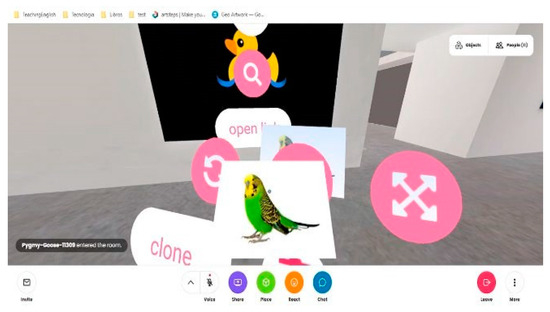
Figure 1.
Micro-story in AR.
In the Construct and Test phases, students used 2D and 3D figures to develop the AR micro-story prototype. The design phase visually represented the case studies with drawings that were later animated in AR using the Paint 3D program (see Figure 2).
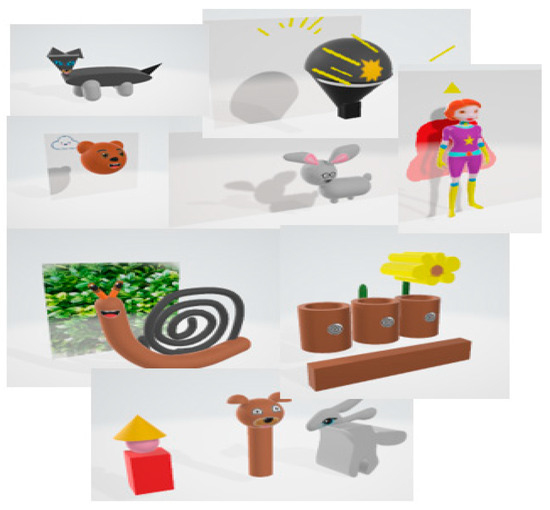
Figure 2.
Three-dimensional models created by the students.
As part of an experiment, the students used Oculus Quest 2 to explore AR level 3 and learn about digital design, as seen in Figure 3. By immersing themselves in a virtual story and creating sensory virtual learning objects, they could engage with the content more meaningfully.
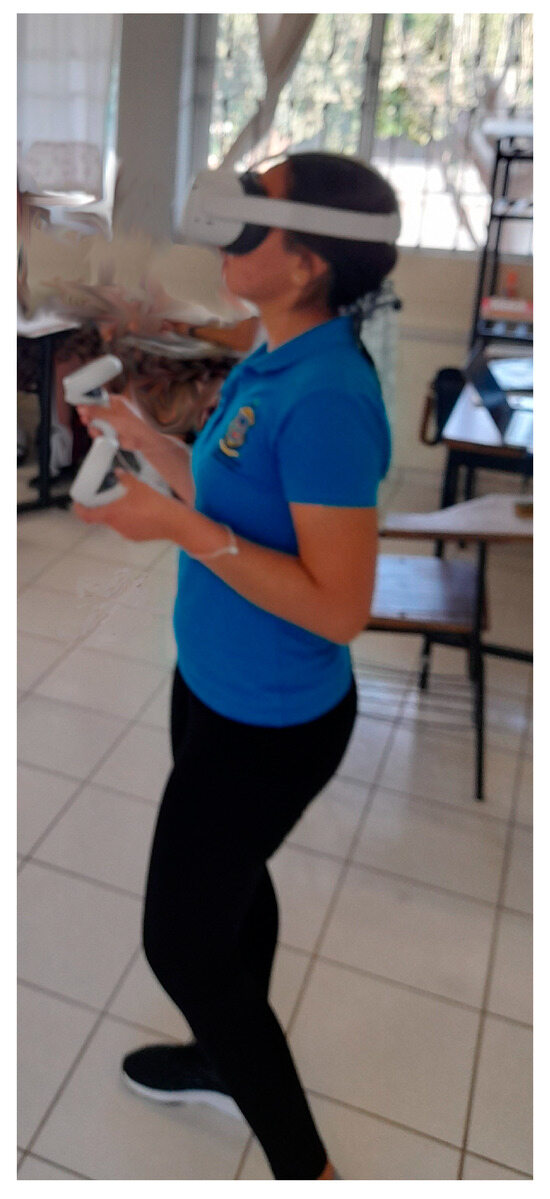
Figure 3.
Use of AR level 3 with the Oculus Quest 2 visor.
Finally, to provide a more immersive and interactive experience, the students were introduced to the metaverse of VR using the Mozilla Hubs platform [31]. In this study phase, they were assigned a thrilling role-playing game of “Following Clues”, where they had to embark on a quest to find a living being that flies, possesses wings, features green and yellow plumage, and has a beak (see Figure 4). As they followed the clues, the students had to engage in collaborative interactions and navigate through the VR space. This experiment phase aimed to assess the students’ adaptability and engagement within an entirely virtual context, promoting teamwork and problem-solving skills in a dynamic and engaging ICT setting.
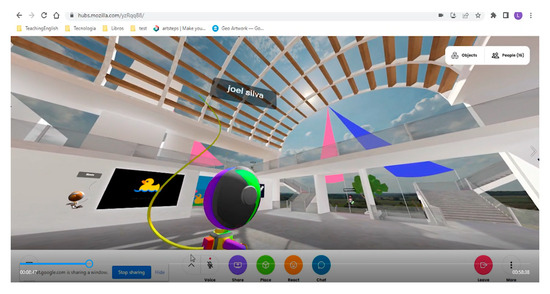
Figure 4.
Use of VR with the cardboard visor.
Incorporating the metaverse experience in the experimental study, the investigation sought to delve further into the potential of VR to facilitate more profound learning experiences and foster a more comprehensive understanding of role-playing activities. The Mozilla Hubs platform provided a unique opportunity for the students to interact with the environment in a novel and captivating way, expanding their perspectives on the educational possibilities of immersive technologies. The data collected during this phase complemented the findings from the AR role-playing activities, providing a more holistic understanding of the impact of these technologies on self-learning and skill development in higher education scenarios.
5. Results
5.1. Photographic Analysis
This study’s analysis of activities conducted during role-playing sessions involving the use of AR and VR learning objects was undertaken. This analysis primarily focuses on the visual component and participant interactions, offering a detailed view of the didactic influence of technology on the educational process.
5.1.1. Rally Activity and QR Code Usage
During the first session, students formed teams, each representing a group of social researchers (see Figure 5). Their task was to search for clues related to their assigned role-play scenario, which involved exploring different locations and using their mobile devices to scan QR codes. This initial approach centered on levels 1 and 2 of AR, incorporating transmedia storytelling to guide knowledge-seeking.
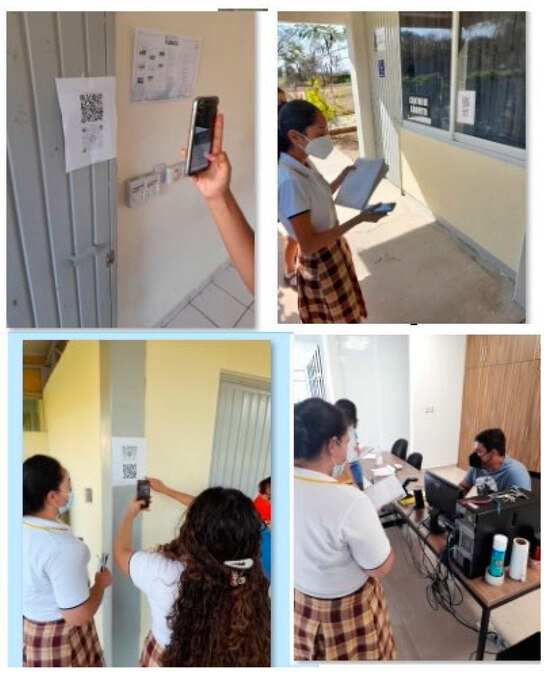
Figure 5.
Students during the rally activity.
After analyzing this activity, it was found that the students quickly adapted to the role-play scenario. They organized themselves into teams based on their assigned roles and efficiently used their mobile devices to scan QR codes and access clues. This initial interaction promoted teamwork and critical thinking skills, laying a solid foundation for future activities.
5.1.2. Creation of Micro-Stories and Transmedia Narrative
Analysis of the development process (see Figure 6) at level 1 included the creation of micro-stories in AR. Students formulated research questions about their assigned case study during the investigator role-play. These questions were used to gather information about observed barriers to learning and participation during their professional practice.
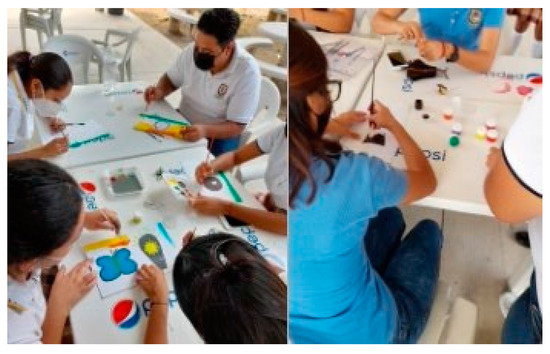
Figure 6.
Students creating transmedia materials.
This activity promoted collaboration among students who worked in teams to design drawings related to the selected case studies. Each student recorded observations and interpretations of the drawings, enriching their understanding of the topic. The resulting micro-stories were presented via QR codes, allowing students to access content related to the micro-story, thus enhancing the learning experience.
5.2. Questionnaire Results
By analyzing the responses to the questionnaire, we gained valuable insights into how role-playing activities using AR and VR affect students’ learning experiences. According to the research, incorporating AR and VR technology into role-playing situations benefited students’ interactions and communication with their classmates. Through the immersive and collaborative nature of the activities, students engaged in effective teamwork, fostering communication and collaboration skills. One student noted, “Yes, there was more communication with peers”. Another student shared, “Yes, it allowed us to use our imagination”. The combination of the STEM instructional framework and creative thinking encouraged the students to envision and create imaginative AR stories, showcasing their abilities to apply acquired knowledge and skills dynamically and innovatively.
In addition, the interactive nature of the role-playing exercises helped the students fully embody the role of social researchers. It led to an improvement in their ability to present their case studies engagingly and playfully. By using an experiential approach, the students were able to gain a better understanding of the case studies they were studying. This approach also helped the students empathize with the subjects they observed, as a student expressed, “The interaction with classmates, more knowledge, and experience in how to conduct a case study”. The transmedia narrative technique in digitalizing the micro-stories provided a unique opportunity for the students to explore and present their findings creatively, fostering a sense of ownership and pride in their work.
While the advantages of AR role-playing activities were evident, this study also uncovered some challenges faced by the students. Due to technical difficulties, some users encountered obstacles while attempting to digitize 2D drawings into 3D using the Paint 3D application. However, the activity allowed the students to develop problem-solving skills as they explored solutions to overcome these obstacles. As one student reflected, “I am not good at creating stories, so it was challenging to come up with ideas or imagine, but when I started drawing the story, it became easy for me”. Another student shared, “I think the difficulties I encountered were in writing the story since it is difficult for me to create stories”. By overcoming challenges, the students were able to improve their digital skills while also developing perseverance and adaptability.
The creation of AR stories during role-playing activities proved beneficial in fostering reading comprehension. By crafting their stories and reading them aloud to their peers, the students engaged in an interactive and dynamic process that deepened their understanding of the subject matter. This approach allowed them to effectively express complex concepts and emotions, promoting critical thinking and analytical skills. One student explained, “By reading the story, imitating or using different voices, fully engaging in the story, and teaching with creativity the drawing that was created”.
The research rally using QR codes was met with enthusiasm by the students, who found it innovative, interactive, and enjoyable. This activity encouraged exploration and independent learning as they searched for clues and answers using QR code reader applications. The combination of technology and gamification made the students’ learning experience exciting and engaging. As one student enthusiastically shared, “It was fun because we were moving around, thinking about the answer to the clues”.
5.3. Sentiment Analysis
AR in role-playing games has proven to be an immersive tool in higher education, promoting student interaction and collaboration. Two specific questions from the questionnaire were analyzed to comprehend the emotional impact of these activities. The first question, Question 8, asked about the emotions experienced while writing stories in AR. The second question, Question 10, explored the emotions felt during role-playing while developing micro-stories in AR.
Figure 7 shows the frequency of positive and negative emotions mentioned in response to both questions. In Question 8, 13 mentions of positive emotions and four mentions of negative emotions were observed, suggesting a generally positive reception of the AR story-writing task. Similarly, in Question 10, 11 mentions of positive and six mentions of negative emotions were recorded, indicating a diverse emotional experience during micro-story development in the role-playing game.
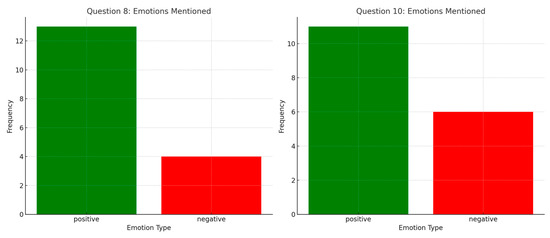
Figure 7.
Sentiment analysis of emotions.
Figure 8 presents a word cloud that visually encapsulates the spectrum of emotions articulated by students in response to Questions 8 and 10, spotlighting the emotional undertones experienced during AR storytelling and role-playing activities. Dominating the visual are the words “Joy” and “Emotion”, presented in larger fonts, underscoring their frequent mention, and thereby hinting at a generally positive emotional experience among participants. The presence of emotions like “Confusion”, “Desperation”, and “Nervousness” interwoven with the predominantly positive emotions suggests a complexity in the students’ emotional journey, where moments of enjoyment and engagement coexist with instances of challenge and uncertainty.
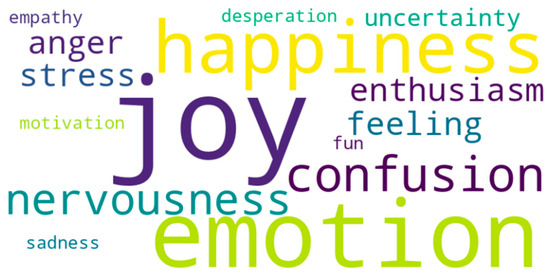
Figure 8.
Word cloud of emotions.
Although the prevalence of positive emotions suggests a generally beneficial and pleasant experience for students, the mentions of negative emotions indicate that challenges and difficulties were also presented that emotionally impacted participants. Specifically, these negative emotions may be linked to obstacles and challenges encountered while developing stories in AR, such as technical problems or creative difficulties.
In order to identify a connection with negative emotions, an analysis was conducted to correlate the responses from Question 3, “What difficulties did you experience while developing the AR story during role-playing activities?”, as patterns may emerge between the encountered difficulties and the negative emotions from Questions 8 and 10. These relationships could provide insights into how challenges faced during the development of AR stories may have influenced student emotions.
5.3.1. Technical Difficulties
Students expressed challenges with understanding and utilizing AR tools effectively, which could be correlated with feelings of enjoyment, as seen in Table 1.

Table 1.
Technical difficulties in relation to emotions.
Participants encountering technical difficulties, particularly in comprehending and using AR tools, exhibited a variety of emotions in the subsequent activities. Despite technological struggles, they expressed predominantly positive emotions like “joy” and “excitement” in Question 8, indicating a positive reception toward writing AR stories. The responses for Question 10 were mostly positive, with words like “fun” and “enthusiasm”, indicating that participants enjoyed creating AR micro-stories within role-playing games despite facing technical difficulties.
This suggests that even though technical challenges were encountered, they did not significantly impact the overall emotional experience. This finding could be due to the engaging nature of the AR activities.
5.3.2. Story Creation
Struggles in imagination and structuring the narrative were highlighted as difficulties in developing stories, which can lead to mixed emotions, as shown in Table 2. The stress and confusion of the creative process can overshadow the joy of creation.

Table 2.
Story creation in relation to emotions.
Participants who encountered challenges in creating and developing stories conveyed a spectrum of emotions. In Question 8, despite the inherent challenges in developing stories, emotions were notably positive, with expressions like “Joy” and “Happiness” surfacing, suggesting that crafting stories in AR was pleasurable. In contrast, responses to Question 10, such as “Desperation”, “stress”, and “confusion”, indicated a blend of emotions. During the creative process, one can experience both joy and desperation. The latter can arise due to struggles with the creative writing process. This highlights that the challenges of creating a story can elicit a complex emotional response. It intertwines the joy of creation with the potential stress or anxiety that may arise from these challenges.
5.3.3. Creative Expression
Participants pointed out challenges in expressing ideas and choosing characters, potentially linked to feelings of insecurity, confusion, and joy, reflecting a bittersweet experience where creative expression was enjoyable and slightly daunting, as seen in Table 3.

Table 3.
Creative expression in relation to emotions.
Participants who expressed difficulties with creative expression and character creation revealed a range of emotions in their responses. In Question 8, responses such as “Joy and emotion” suggest a wholesome emotional experience. Meanwhile, in Question 10, expressions like “Happiness, confusion, emotion, and anger” unveil a multifaceted emotional response to developing micro-stories, where the happiness derived from creative expression is juxtaposed with confusion and anger, possibly related to struggles with embodying creativity in the AR platform. While creative expression in AR is enriching and enjoyable, it also introduces emotional complexity, where positive emotions coexist with potential emotional struggles tied to the creative process.
This analysis illustrates the importance of considering students’ emotional experiences in innovative and technologically advanced learning activities. Although these activities can offer enriching and exciting opportunities for interactive learning and collaboration, they can also present challenges that require adequate support and guidance to ensure positive and effective learning experiences for all students.
Future research could explore the circumstances and factors contributing to negative emotions to develop strategies and supports that minimize these challenges and enhance positive experiences and learning outcomes.
6. Discussion
Using role-playing activities in AR and VR environments was effective in helping students express and reflect on their learning experiences. Students could immerse themselves in various scenarios through these activities, engaging in dynamic interactions with their peers and the digital content. This immersive experience helped bridge the gap between virtual and in-person learning environments, as students felt actively involved in the learning process despite being in a digital setting. Integrating asynchronous and synchronous activities further enriched their skills in using inclusive technology for educational purposes, contributing to their overall digital literacy.
VR and AR have gained increasing interest in higher education, especially in role-playing games that promote self-learning. Oyelere et al.’s systematic review [32] highlights the emergence of Educational VR Games (EVRGs) as a catalyst for transformative educational experiences at different levels, including higher education. Our study supports this trend, demonstrating how role-playing in VR and AR environments enhances self-learning, critical thinking, and creative application among higher education students, in line with current literature.
By incorporating STEM teaching practices, the experiment encouraged critical thinking and problem-solving skills among the students. The creation of AR micro-stories necessitated creative thinking and the application of knowledge to craft engaging narratives. This experiential learning approach allowed students to develop a deeper understanding of the lessons as they become active creators of knowledge rather than passive recipients. Moreover, the use of AR and VR technology provided a unique opportunity for students to explore their creativity and present their findings visually compellingly. Upon further comparison with other studies, it was revealed that although traditional teaching methods have their benefits, the immersive digital experiences offered by VR and AR tend to provide a more engaging learning environment. They allow for a deeper level of engagement with complex materials beyond what can be achieved with conventional lectures and textbooks, providing opportunities for personalized learning experiences [33].
This exploration unveiled a blend of emotions experienced by students, with a generally positive inclination toward AR activities, but not without the presence of negative emotions arising from various difficulties. While the innovative approach of integrating AR in role-playing was found to be engaging and imaginative, it is crucial to acknowledge the emotional and technical challenges encountered by the students. Identifying and developing strategies to minimize these hurdles could enhance the learning experience, ensuring it is innovative, emotionally supportive, and educationally productive.
This complex emotional landscape sheds light on the intricate relationship between technology, creativity, and emotional response in educational activities. It also highlights areas for further exploration and support in future implementations of AR in learning environments.
The positive response from students toward the AR and VR role-playing activities underscores the potential of these immersive educational experiences to enhance self-learning in higher education contexts. This sentiment is supported by the existing literature on the pedagogical advantages of VR and AR [34,35].
Future research and implementations may further focus on providing additional support in areas identified as challenging, such as technical guidance, creative writing workshops, and emotional support, to nurture positive learning experiences in technologically advanced educational activities.
The teacher’s role in crafting a comprehensive virtual classroom plan must be considered. The experiment’s success relied heavily on the teacher’s ability to design and implement various activities and strategies aligned with the learning objectives. With the teacher’s guidance and facilitation during role-playing exercises, students could better understand the lessons and connect them to real-world scenarios based on their experiences.
7. Limitations
Although our study provided valuable insights into using AR and VR role-playing activities in higher education, it is essential to acknowledge its limitations. Firstly, this study was conducted in a specific higher education setting, focusing on a particular subject and semester. Thus, the context of our study may limit the generalizability of our findings to other academic institutions or disciplines. Secondly, this study relied on a relatively small sample size, with only 11 students participating. A more extensive and diverse sample could offer a broader perspective on the impact of AR and VR in higher education.
This study evaluated the immediate impact of AR and VR role-playing activities but did not assess long-term effects and sustained learning outcomes. Future studies could investigate the durability of the skills and knowledge acquired through these immersive experiences. Additionally, this study could have provided a more in-depth analysis of students’ technical challenges while using AR and VR technology. Developing effective strategies to address these challenges could improve the overall learning experience.
Our research methodology uses an action research approach, but we do not include a control group. There are both advantages and disadvantages to this methodological choice. On the one hand, it allows us to explore the phenomenon under study in a way that enhances our understanding of the processes and dynamics involved. It is important to acknowledge that our findings may need to be generalizable due to the absence of a control group, which limits our ability to establish definitive causal relationships. However, despite this limitation, the action research approach has enriched our research by providing a valuable qualitative perspective that complements our analysis of using AR and VR role-playing activities in higher education.
Although there are some limitations, our research has provided valuable insights into how AR and VR can be utilized in higher education. Further studies can expand on our findings and explore the transformative effects of immersive technologies on self-directed learning and skill development.
8. Conclusions
This project evaluated the impact of AR and VR learning objects on developing both generic competencies related to ICT and professional competencies in inclusive teaching strategies. The evaluation criteria focused on the quality of the learning objects, the effectiveness of collaborative work among students, and the final prototype of the micro-story in AR. The findings showed that the integration of AR and VR technology positively impacted the students’ competency development.
In conclusion, combining AR and VR technology with role-playing activities in higher education offers a promising pathway for enhancing self-learning and promoting active student engagement. The immersive and interactive nature of these activities fosters creativity, critical thinking, and collaboration, empowering students to become active participants in their educational journey. As educational institutions continue to embrace innovative technologies, integrating AR and VR in higher education holds immense potential for transforming how students learn and prepare for a technology-driven world.
Author Contributions
Methodology, L.V.R. and R.A.-D.; formal analysis, P.C.S.-M. and R.A.-D.; data curation, L.V.R., R.A.-D. and P.C.S.-M.; writing—original draft preparation, P.C.S.-M. and L.V.R.; writing—review and editing, R.A.-D. All authors have read and agreed to the published version of the manuscript.
Funding
This research received no external funding.
Institutional Review Board Statement
This study was approved by the Higher Institute of Normal Education of the State of Colima (ISENCO), campus Cuauhtémoc, Colima, Mexico.
Informed Consent Statement
Informed consent was obtained from all subjects involved in this study.
Data Availability Statement
The data presented in this study are available upon request from the first author.
Acknowledgments
We thank the program authorities of “Licenciatura en inclusión educativa” at the Higher Institute of Normal Education of the State of Colima (ISENCO), campus Cuauhtémoc, Colima, Mexico. Their support and cooperation were invaluable throughout the research process. We also sincerely thank the students of the “Herramientas básicas de estudios de casos” course for actively participating in this study. Their involvement made this study possible.
Conflicts of Interest
The authors declare no conflict of interest.
Appendix A
This appendix contains the questionnaire used to collect insights from the participants in our study on the impact of augmented and virtual reality role-playing activities. The questionnaire assesses various aspects of creating augmented reality stories during the role-playing sessions, including inquiries about the emotions experienced by the participants. The original questions are in Spanish to ensure a comprehensive understanding for the participating students, who are native Spanish speakers.
- Did the elaboration of stories in augmented reality during the role-playing games favor the interaction between your classmates?
- Based on your perception, what did the dynamics during the role-playing activities foster?
- What difficulties did you experience while developing the augmented reality story during role-playing activities?
- What advantages did the creation of augmented reality stories during role-playing activities offer?
- In your opinion, how does the creation of augmented reality stories contribute to fostering reading comprehension?
- What are your thoughts on the research rally using QR codes?
- What is your opinion about the digital skills used in developing augmented reality micro-stories during role-playing activities?
- What emotions did you experience while writing stories in augmented reality during role-playing games?
- What socioemotional skills were developed while creating micro-stories in augmented reality during role-playing?
- What emotions did you feel while developing micro-stories in augmented reality during the role-playing game?
References
- Rodriguez Villamil, H. Del Constructivismo al Construccionismo: Implicaciones Educativas. Rev. Educ. Desarro. Soc. 2008, 2, 71–89. [Google Scholar]
- Fainholc, B. Presente y Futuro Latinoamericano de La Enseñanza y El Aprendizaje En Entornos Virtuales Referidos a Educación Universitaria. RED Rev. Educ. Distancia 2016, 48, 1–22. [Google Scholar] [CrossRef]
- Zambrano-Ramírez, J. Aprendizaje Complejo En La Educación Superior Ecuatoriana. Rev. Cienc. UNEMI 2016, 9, 158–167. [Google Scholar] [CrossRef]
- Grande de Prado, M.; Abella Garcia, V. Los Juegos de Rol En El Aula. Teoría Educ. Educ. Cult. Soc. Inf. 2010, 11. [Google Scholar] [CrossRef]
- Tomlinson, H. (Ed.) Educational Leadership; RoutledgeFalmer: London, UK, 2004; ISBN 978-0-415-27651-1. [Google Scholar]
- Lee, S.Y.; Kim, Y. The Effects of Self-Efficacy and Self-Directed Learning Readiness to Self-Leadership of Nursing Student. J. Digit. Converg. 2016, 14, 309–318. [Google Scholar] [CrossRef]
- Knowles, M.S. Self-Directed Learning: A Guide for Learners and Teachers; Association Press: Chicago, IL, USA, 1975; ISBN 978-0-695-81116-7. [Google Scholar]
- Santana-Mancilla, P.C.; Garcia-Ruiz, M.A.; Acosta-Diaz, R.; Juarez, C.U. Service Oriented Architecture to Support Mexican Secondary Education through Mobile Augmented Reality. Procedia Comput. Sci. 2012, 10, 721–727. [Google Scholar] [CrossRef]
- Yee, N.; Bailenson, J. The Proteus Effect: The Effect of Transformed Self-Representation on Behavior. Hum. Commun. Res. 2007, 33, 271–290. [Google Scholar] [CrossRef]
- Azuma, R.T. Survey of Augmented Reality. Presence Teleoperators Virtual Environ. 1997, 6, 355–385. [Google Scholar] [CrossRef]
- Milgram, P.; Takemura, H.; Utsumi, A.; Kishino, F. Augmented Reality: A Class of Displays on the Reality-Virtuality Continuum. In Proceedings of the SPIE—The International Society for Optical Engineering, Boston, MA, USA, 21 December 1995; Das, H., Ed.; pp. 282–292. [Google Scholar]
- Lampropoulos, G.; Keramopoulos, E.; Diamantaras, K.; Evangelidis, G. Augmented Reality and Gamification in Education: A Systematic Literature Review of Research, Applications, and Empirical Studies. Appl. Sci. 2022, 12, 6809. [Google Scholar] [CrossRef]
- Krug, M.; Czok, V.; Huwer, J.; Weitzel, H.; Müller, W. Challenges for the Design of Augmented Reality Applications for Science Teacher Education. In Proceedings of the 15th International Technology, Education and Development Conference, Online Conference, 8–9 March 2021; pp. 2484–2491. [Google Scholar]
- Cakir, R.; Korkmaz, O. The Effectiveness of Augmented Reality Environments on Individuals with Special Education Needs. Educ. Inf. Technol. 2019, 24, 1631–1659. [Google Scholar] [CrossRef]
- Karageorgiou, Z.; Mavrimmati, E.; Fotaris, P. Escape Room Design as a Game-Based Learning Process for STEAM Education. In Proceedings of the 12th European Conference on Game Based Learning, Sophia Antipolis, France, 3 October 2019; p. 46. [Google Scholar]
- Warmelink, H.; Mayer, I.; Weber, J.; Heijligers, B.; Haggis, M.; Peters, E.; Louwerse, M. AMELIO: Evaluating the Team-Building Potential of a Mixed Reality Escape Room Game. In Proceedings of the Extended Abstracts Publication of the Annual Symposium on Computer-Human Interaction in Play, Amsterdam, The Netherlands, 15 October 2017; ACM: Amsterdam, The Netherlands; pp. 111–123. [Google Scholar]
- Hess, O.; Qian, J.; Bruce, J.; Wang, E.; Rodriguez, S.; Haber, N.; Caruso, T.J. Communication Skills Training Using Remote Augmented Reality Medical Simulation: A Feasibility and Acceptability Qualitative Study. Med. Sci. Educ. 2022, 32, 1005–1014. [Google Scholar] [CrossRef] [PubMed]
- Mikropoulos, T.A.; Chalkidis, A.; Katsikis, A.; Emvalotis, A. Students’ Attitudes Towards Educational Virtual Environments. Educ. Inf. Technol. 1998, 3, 137–148. [Google Scholar] [CrossRef]
- Antonietti, A.; Rasi, C.; Imperio, E.; Sacco, M. The Representation of Virtual Reality in Education. Educ. Inf. Technol. 2000, 5, 317–327. [Google Scholar] [CrossRef]
- Matome, T.J.; Jantjies, M.E. Student Perceptions of Virtual Reality in Higher Education. In Proceedings of the 16th International Conference on Cognition and Exploratory Learning in Digital Age (CELDA 2019), Cagliari, Italy, 7–9 November 2019; IADIS Press: Porto, Portugal; pp. 92–100. [Google Scholar]
- Serin, H. Virtual Reality in Education from the Perspective of Teachers. Amazonia Investig. 2020, 9, 291–303. [Google Scholar] [CrossRef]
- Sural, I. Augmented Reality Experience: Initial Perceptions of Higher Education Students. Int. J. Instruction. 2018, 11, 565–576. [Google Scholar] [CrossRef]
- Bower, M.; Howe, C.; McCredie, N.; Robinson, A.; Grover, D. Augmented Reality in Education—Cases, Places, and Potentials. In Proceedings of the 2013 IEEE 63rd Annual Conference International Council for Education Media (ICEM), Singapore, 1–4 October 2013; IEEE: Singapore, 2013; pp. 1–11. [Google Scholar]
- Bower, M.; Howe, C.; McCredie, N.; Robinson, A.; Grover, D. Augmented Reality in Education—Cases, Places and Potentials. Educ. Media Int. 2014, 51, 1–15. [Google Scholar] [CrossRef]
- Rizov, T.; Rizova, E. Augmented Reality as a Teaching Tool in Higher Education. Int. J. Cogn. Res. Sci. Eng. Educ. 2015, 3, 7–15. [Google Scholar] [CrossRef]
- Latorre-Beltrán, A. La Investigación-Acción: Coniocer y Cambiar la Práctica Educativa, 1st ed.; Graó: Barcelona, Spain, 2010; ISBN 978-84-7827-292-1. [Google Scholar]
- Fernández Batanero, J.M. Capacidades y Competencias Docentes Para La Inclusión Del Alumnado En La Educación Superior. Rev. Educ. Super. 2012, 61, 9–24. [Google Scholar]
- Bonetto, M.J. El Uso de La Fotografía En La Investigación Social. Rev. Latinoam. Metodol. Investig. Soc. 2016, 6, 71–83. [Google Scholar]
- Marshall, G. The Purpose, Design and Administration of a Questionnaire for Data Collection. Radiography 2005, 11, 131–136. [Google Scholar] [CrossRef]
- Santana-Mancilla, P.C.; Rodriguez-Ortiz, M.A.; Garcia-Ruiz, M.A.; Gaytan-Lugo, L.S.; Fajardo-Flores, S.B.; Contreras-Castillo, J. Teaching HCI Skills in Higher Education through Game Design: A Study of Students’ Perceptions. Informatics 2019, 6, 22. [Google Scholar] [CrossRef]
- Brown, R.; Habibi-Luevano, S.; Robern, G.; Wood, K.; Perera, S.; Uribe-Quevedo, A.; Brown, C.; Rizk, K.; Genco, F.; McKellar, J.; et al. Employing Mozilla Hubs as an Alternative Tool for Student Outreach: A Design Challenge Use Case. In New Realities, Mobile Systems and Applications; Auer, M.E., Tsiatsos, T., Eds.; Lecture Notes in Networks and Systems; Springer International Publishing: Cham, Switzerland, 2022; Volume 411, pp. 213–222. ISBN 978-3-030-96295-1. [Google Scholar]
- Oyelere, S.S.; Bouali, N.; Kaliisa, R.; Obaido, G.; Yunusa, A.A.; Jimoh, E.R. Exploring the Trends of Educational Virtual Reality Games: A Systematic Review of Empirical Studies. Smart Learn. Environ. 2020, 7, 31. [Google Scholar] [CrossRef]
- Al-Ansi, A.M.; Jaboob, M.; Garad, A.; Al-Ansi, A. Analyzing Augmented Reality (AR) and Virtual Reality (VR) Recent Development in Education. Soc. Sci. Humanit. Open 2023, 8, 100532. [Google Scholar] [CrossRef]
- Bermejo, B.; Juiz, C.; Cortes, D.; Oskam, J.; Moilanen, T.; Loijas, J.; Govender, P.; Hussey, J.; Schmidt, A.L.; Burbach, R.; et al. AR/VR Teaching-Learning Experiences in Higher Education Institutions (HEI): A Systematic Literature Review. Informatics 2023, 10, 45. [Google Scholar] [CrossRef]
- Dick, E. The Promise of Immersive Learning: Augmented and Virtual Reality’s Potential in Education; Information Technology & Innovation Fundation: Washington, DC, USA, 2021. [Google Scholar]
Disclaimer/Publisher’s Note: The statements, opinions and data contained in all publications are solely those of the individual author(s) and contributor(s) and not of MDPI and/or the editor(s). MDPI and/or the editor(s) disclaim responsibility for any injury to people or property resulting from any ideas, methods, instructions or products referred to in the content. |
© 2023 by the authors. Licensee MDPI, Basel, Switzerland. This article is an open access article distributed under the terms and conditions of the Creative Commons Attribution (CC BY) license (https://creativecommons.org/licenses/by/4.0/).